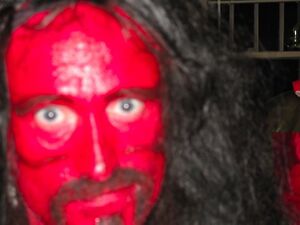Demon (nonfiction): Difference between revisions
No edit summary |
|||
| Line 14: | Line 14: | ||
File:Diablo III cover.png|Cover art for ''Diablo III'' possessed by demons. | File:Diablo III cover.png|Cover art for ''Diablo III'' possessed by demons. | ||
File:Kylix_demon_620_BC.jpg|Winged snake-tailed demon seeks new challenges. | File:Kylix_demon_620_BC.jpg|Winged snake-tailed demon seeks new challenges. | ||
File:Zahhak is nailed to wall of cave in Mount Damavand.jpg|link=Zahhak (nonfiction)| [[Zahhak (nonfiction)|Zahhak]] nailed to wall of cave in Mount Davamand in bizarre sadomasochistic ritual. | |||
</gallery> | </gallery> | ||
Revision as of 06:34, 17 June 2016

A demon (from Koine Greek δαιμόνιον daimonion), or fiend is a supernatural, often malevolent being prevalent in religion, occultism, literature, fiction, mythology and folklore. See also Monster.
The original Greek word daimon does not carry the negative connotation initially understood by implementation of the Koine δαιμόνιον (daimonion), and later ascribed to any cognate words sharing the root.
In Ancient Near Eastern religions as well as in the Abrahamic traditions, including ancient and medieval Christian demonology, a demon is considered an unclean spirit, a fallen angel, or a spirit of unknown type which may cause demonic possession, calling for an exorcism.
In Western occultism and Renaissance magic, which grew out of an amalgamation of Greco-Roman magic, Jewish Aggadah and Christian demonology, a demon is believed to be a spiritual entity that may be conjured and controlled.
In the News
Demon-hunters capture their prey. One hunter grips the demon's feet, another its hands, while the third weaves a sacred ligature around the demon's neck.
Slate-Waker hired to frighten off demons.
Zahhak nailed to wall of cave in Mount Davamand in bizarre sadomasochistic ritual.
Fiction cross-reference
Nonfiction cross-reference
External links:




